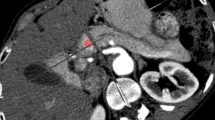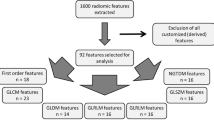Abstract
Purpose
Grades of pancreatic neuroendocrine neoplasms (PNENs) are associated with the choice of treatment strategies. Texture analysis has been used in tumor diagnosis and staging evaluation. In this study, we aim to evaluate the potential ability of texture parameters in differentiation of PNENs grades.
Materials and methods
37 patients with histologically proven PNENs and underwent pretreatment dynamic contrast-enhanced computed tomography examinations were retrospectively analyzed. Imaging features and texture features at contrast-enhanced images were evaluated. Receiver operating characteristic curves were used to determine the cut-off values and the sensitivity and specificity of prediction.
Results
There were significant differences in tumor margin, pancreatic duct dilatation, lymph nodes invasion, size, portal enhancement ratio (PER), arterial enhancement ratio (AER), mean grey-level intensity, kurtosis, entropy, and uniformity among G1, G2, and pancreatic neuroendocrine carcinoma (PNEC) G3 (p < 0.01). Similar results were found between pancreatic neuroendocrine tumors (PNETs) G1/G2 and PNEC G3. AER and PER showed the best sensitivity (0.86–0.94) and specificity (0.92–1.0) for differentiating PNEC G3 from PNETs G1/G2. Mean grey-level intensity, entropy, and uniformity also showed acceptable sensitivity (0.73–0.91) and specificity (0.85–1.0). Mean grey-level intensity was also showed acceptable sensitivity (91% to 100%) and specificity (82% to 91%) in differentiating PNET G1 from PNET G2.
Conclusions
Our data indicated that texture parameters have potential in grading PNENs, in particular in differentiating PNEC G3 from PNETs G1/G2.




Similar content being viewed by others
References
Wang Y, Miller FH, Chen ZE, et al. (2011) Diffusion-weighted MR imaging of solid and cystic lesions of the pancreas. Radiographics 31(3):E47–E64
Dasari A, Shen C, Halperin D, et al. (2017) Trends in the incidence, prevalence, and survival outcomes in patients with neuroendocrine tumors in the United States. JAMA Oncol 3:1335–1342
Klimstra DS, Arnold R, Capella C (2010) Neuroendocrine neoplasms of the pancreas. In: Bosman FT, Carneiro F, Hruban RH, Theise ND (eds) WHO Classification of Tumours of the Digestive System. Lyon: International Agency for Research on Cancer (IARC), pp 322–326
Kulke MH, Shah MH, Benson Al B, et al. (2014) NCCN guidelines Neuroendocrine tumors version 2. Accessed March.
Burns WR, Edil BH (2012) Neuroendocrine pancreatic tumors: guidelines for management and update. Curr Treat Options Oncol 13(1):24–34
Yao JC, Shah MH, Ito T, et al. (2011) RAD001 in Advanced Neuroendocrine Tumors, Third Trial (RADIANT-3) Study Group. Everolimus for advanced pancreatic neuroendocrine tumors. N Engl J Med 364(6):514–523
Raymond E, Dahan L, Raoul JL, et al. (2011) Sunitinib malate for the treatment of pancreatic neuroendocrine tumors. N Engl J Med 364(6):501–513
Cappelli C, Boggi U, Mazzeo S, et al. (2015) Contrast enhancement pattern on multidetector CT predicts malignancy in pancreatic endocrine tumours. Eur Radiol 25(3):751–759
Kim DW, Kim HJ, Kim KW, et al. (2015) Neuroendocrine neoplasms of the pancreas at dynamic enhanced CT: comparison between grade 3 neuroendocrine carcinoma and grade 1/2 neuroendocrine tumour. Eur Radiol 25(5):1375–1383
Takumi K, Fukukura Y, Higashi M, et al. (2015) Pancreatic neuroendocrine tumors: Correlation between the contrast-enhanced computed tomography features and the pathological tumor grade. Eur J Radiol 84(8):1436–1443
Horiguchi S, Kato H, Shiraha H, et al. (2017) Dynamic computed tomography is useful for prediction of pathological grade in pancreatic neuroendocrine neoplasm. J Gastroenterol Hepatol 32(4):925–931
Lotfalizadeh E, Ronot M, Wagner M, et al. (2017) Prediction of pancreatic neuroendocrine tumour grade with MR imaging features: added value of diffusion-weighted imaging. Eur Radiol 27(4):1748–1759
Guo C, Chen X, Xiao W, et al. (2017) Pancreatic neuroendocrine neoplasms at magnetic resonance imaging: comparison between grade 3 and grade 1/2 tumors. Onco Targets Ther 10:1465–1474
Giganti F, Antunes S, Salerno A, et al. (2017) Gastric cancer: texture analysis from multidetector computed tomography as a potential preoperative prognostic biomarker. Eur Radiol 27(5):1831–1839
Aerts HJ, Velazquez ER, Leijenaar RT, et al. (2014) Decoding tumour phenotype by noninvasive imaging using a quantitative radiomics approach. Nat Commun 5:4006
Choi ER, Lee HY, Jeong JY, et al. (2016) Quantitative image variables reflect the intratumoral pathologic heterogeneity of lung adenocarcinoma. Oncotarget 7(41):67302–67313
Summers RM (2017) Texture analysis in radiology: Does the emperor have no clothes? Abdom Radiol (NY) 42(2):342–345
Sacconi B, Anzidei M, Leonardi A, et al. (2017) Analysis of CT features and quantitative texture analysis in patients with lung adenocarcinoma: a correlation with EGFR mutations and survival rates. Clin Radiol 72(6):443–450
Ramkumar S, Ranjbar S, Ning S, et al. (2017) MRI-based texture analysis to differentiate sinonasal squamous cell carcinoma from inverted papilloma. AJNR Am J Neuroradiol 38(5):1019–1025
Nketiah G, Elschot M, Kim E, et al. (2017) T2-weighted MRI-derived textural features reflect prostate cancer aggressiveness: preliminary results. Eur Radiol 27(7):3050–3059
Kim JH, Ko ES, Lim Y, et al. (2017) Breast cancer heterogeneity: MR imaging texture analysis and survival outcomes. Radiology 282(3):665–675
Zhang S, Zhang B, Tian J, et al. (2017) Radiomics features of multiparametric MRI as novel prognostic factors in advanced nasopharyngeal carcinoma. Clin Cancer Res 23(15):4259–4269
Pereira JA, Rosado E, Bali M, et al. (2015) Pancreatic neuroendocrine tumors: correlation between histogram analysis of apparent diffusion coefficient maps and tumor grade. Abdom Imaging 40(8):3122–3128
Canellas R, Burk KS, Parakh A, et al. (2018) Prediction of pancreatic neuroendocrine tumor grade based on CT features and texture analysis. AJR Am J Roentgenol 210(2):341–346
Choi TW, Kim JH, Yu MH, et al. (2018) Pancreatic neuroendocrine tumor: prediction of the tumor grade using CT findings and computerized texture analysis. Acta Radiol 59(4):383–392
Ganeshan B, Miles KA, Young RC, et al. (2007) Hepatic entropy and uniformity: additional parameters that can potentially increase the effectiveness of contrast enhancementduring abdominal CT. Clin Radiol 62(8):761–768
Miles KA, Ganeshan B, Hayball MP (2013) CT texture analysis using the filtration-histogram method: what do the measurements mean? Cancer Imaging 13(3):400–406
Goh V, Ganeshan B, Nathan P, et al. (2011) Assessment of response to tyrosine kinase inhibitors in metastatic renal cell cancer: CT texture as a predictive biomarker. Radiology 261(1):165–171
Rao SX, Lambregts DM, Schnerr RS, et al. (2014) Whole-liver CT texture analysis in colorectal cancer: Does the presence of liver metastases affect the texture of the remaining liver? United Eur Gastroenterol J 2(6):530–538
Li M, Fu S, Zhu Y, et al. (2016) Computed tomography texture analysis to facilitate therapeutic decision making in hepatocellular carcinoma. Oncotarget 7(11):13248–13259
Miles KA, Ganeshan B, Griffiths MR, et al. (2009) Colorectal cancer: texture analysis of portal phase hepatic CT images as a potential marker of survival. Radiology 250(2):444–452
Guggenbuhl P, Chappard D, Garreau M, et al. (2008) Reproducibility of CT-based bone texture parameters of cancellous calf bone samples: influence of slice thickness. Eur J Radiol 67(3):514–520
Author information
Authors and Affiliations
Corresponding authors
Ethics declarations
Funding
This study was supported by the Zhejiang Medical Science and Technology Project (2017KY331) and Primary Research & Development Plan of Jiangsu Province (BE2017772).
Disclosures
The authors do not have any possible conflicts of interest.
Ethical approval
This retrospective study was approved by the Institutional Review Board of the First Affiliated Hospital, College of Medicine Zhejiang University. For this retrospective study, the requirement of the formal consent was waived.
Rights and permissions
About this article
Cite this article
Guo, C., Zhuge, X., Wang, Z. et al. Textural analysis on contrast-enhanced CT in pancreatic neuroendocrine neoplasms: association with WHO grade. Abdom Radiol 44, 576–585 (2019). https://doi.org/10.1007/s00261-018-1763-1
Published:
Issue Date:
DOI: https://doi.org/10.1007/s00261-018-1763-1




